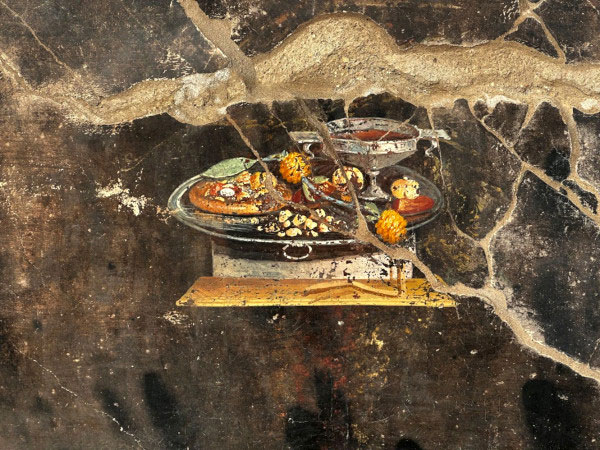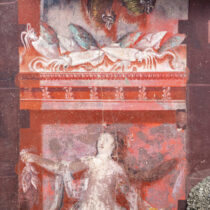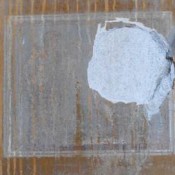What is seen in a 2000-year-old Pompeian painting might look like a pizza, although, obviously, it can’t be, given the absence of several characteristic ingredients, such as tomatoes and mozzarella. Still, a preliminary iconographical analysis of a fresco depicting still life, uncovered recently during the latest excavations at Insula 10 of the Regio IX area at Pompeii, suggests that what is represented on the wall of an ancient Pompeian home is a distant ancestor of the modern dish, which, since 2017, is World Heritage in the form of “the traditional art of the Neapolitan pizza maker”.
As the archaeologists of the Archaeological Park of Pompeii explain, it is supposed that next to a chalice of wine, placed on a silver tray, is depicted a bread, flat in form, which functions as support for various fruit (especially a pomegrenate and maybe a date), covered at times or maybe lightly with a type of pesto (moretum in Latin) which is indicated with yellowish and ochre dots. All in all, dried fruit and a garland of yellow berries are presented on the same tray, next to dates and pomegranates.
This type of depiction, known in antiquity as xenia, originated from the “welcoming gifts” offered to the guests according to a Greek tradition dating back to the Hellenistic Period (3rd-1st c. BC) . Of the thirty or so such representations known from the Vesuvian cities, some often applied to the sacred sphere, while others are solely connected with hospitality. Stll, among the attestations found so far there is not an exact parallel of the recently discovered fresco, which is also striking for its remarkable quality of execution.
According to a passage from Virgil’s Aineid (Book VII.128 ff.) it was possible to dedicate fruit and other agricultural products on sacrificial breads functioning as tables. From the moment the Trojan heroes eat the fruits, as well as these breads which are used as containers (tables), they realize that the prophecy according to which they must find a new home has been fulfilled, “Son, when you’re carried to an unknown shore, food is lacking, and you’re forced to eat the tables, then look for a home” (translated by A. S. Kline).
“Pompeii never ceases to amaze, it is a box that always reveals new treasures,” says Minister of Culture, Gennaro Sangiuliano. “Beyond the question of merit on which researchers will speak, we must underline the global value of this site in which we are dedicating our care, with the closure of the Great Pompeii Project but also with the launch of new initiatives. The protection and development of heritage, according to Article 9 of the Constitution, are an absolute priority”.
“In addition to the precise identification of the food which is represented, in this fresco we find several themes of the Hellenistic tradition, which are later elaborated by authors of the Roman imperial era, such as Virgil, Martial and Philostratus”, comments the director of the Archaeological Park of Pompeii, Gabriel Zuchtriegel. “I am thinking of the contrast between a frugal and simple dish, which refers to a sphere between the bucolic and the sacred, on the one hand, and the luxury of silver trays and the refinement of artistic and literary representations, on the other. How can we think, in this framework, of pizza, which was also born as a ‘poor’ dish in southern Italy, but which has now conquered the world and is served in starred restaurants?”
The fresco was found in the atrium of a house in Insula 10 of Regio IX, where excavation is ongoing. A bakery, partially explored between 1888 and 1891, and whose investigations were resumed in January last year, was annexed to this house.
The structures excavated in the 19th century and partially visible allowed researchers to suggest the presence of a large atrium with the typical succession of rooms on the eastern side and, on the opposite side, the entrance to the production sector of the oven.
The atrium was freed from the resulting material of the 19th-century excavations revealing the collapse of the roofs, within the layer of white pumice and a residual portion of the volcanic layers from flow (cinerites) in the southern sector. In the working areas near the oven, the skeletons of three victims have been found in the past weeks.
The entire excavation site of Insula 9 covers an area of c. 3,200 sq. m., almost an entire block of the ancient city buried in 79 AD by Vesuvius. The excavation is part of a broader approach, developed over the last decade and aimed at rectifying and solving hydrogeological and conservation issues of the excavation’s fronts, i.e. the border between the excavated and the unexplored part of the ancient city. The latter, of about 22 hectares of blocks and houses still buried under lapilli and ash, equals to almost a third of the ancient town.
The Archaeological Park of Pompeii has published a preliminary historical-archaeological overview of the fresco in the E-Journal of the Pompeii Excavations, which can be consulted freely on the website www.pompeiisites.org and is functional for the timely sharing of scientific data from excavations and research ongoing in the UNESCO site and in its territory.





